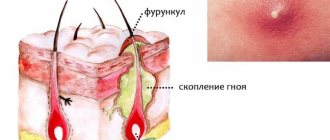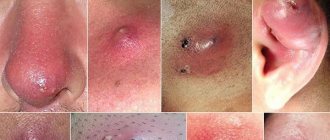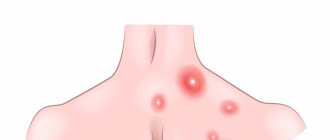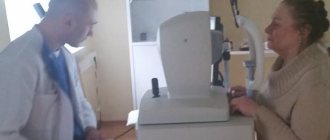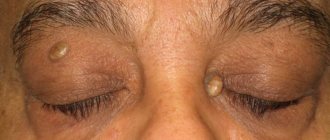Symptoms
The boil develops gradually, going through three stages: formation of infiltrate, suppuration and rejection of the purulent core, healing. At the first stage, tingling, burning, and pulsation are felt. The area gradually turns red, becomes denser and slightly rises above the skin.
In the center of the cone-shaped inflamed area, the upper part of the purulent capsule, the pustule, is visible. On the fourth day, the abscess acquires its maximum size - from one to three cm in diameter. After “ripening,” the pustule opens (usually spontaneously or from an accidental touch), and pus comes to the surface. The capsule is separated by light pressure on adjacent areas of the skin or “pushed out” with special preparations.
If boils appear in several places or after the healing of one abscess the next one quickly forms, then it is necessary to carry out a comprehensive diagnosis to identify the cause of the disease.
Furuncle or pimple?
Furuncle or pimple?
A strange formation appeared on the tip of my nose, like a large pimple. It hurts a lot when I touch it. I heard that such pimples are called boils and they definitely need to be removed. Is it so?
T.S. GLEBOVA, Nizhny Novgorod.
Otorhinolaryngologist, doctor of the highest category, candidate of medical sciences Petr Aleksandrovich KOCHETKOV (Moscow) explains.
— As you know, there are hairs on human skin. Each hair has a hair follicle - a follicle. Small hairs grow in people's noses, protecting the sinuses from dust, cold and other irritants.
A furuncle (an inflammatory process of the skin of the nose) occurs due to the penetration of infection into the hair follicle. When bacteria multiply, a purulent focus is formed, which, increasing, rises above the surface of the skin - this is how a boil appears. It can form both in the vestibule of the nose and on its back or wings.
The onset of the disease is acute . There is slight discomfort in the area of the vestibule of the nose, which gradually increases and turns into pain. Pain is often absent at rest and appears when touching the nose, sharp inhalation or exhalation. Upon visual examination, you can notice swelling in the vestibule of the nose, the skin acquires a reddish tint (inflammatory hyperemia).
This condition lasts from several hours to 2-3 days, after which an area of pus breakthrough becomes noticeable at the top of the pimple. However, with boils, purulent discharge can break out not only outside, but also into the tissue. In this case, swelling and soreness of the cheek, upper lip and even eyelids appear. The listed symptoms are an absolute indication for an autopsy of the boil in a specialized ENT office.
There can be many reasons for the development of the disease . The main ones are the following:
- introduction of infection into soft tissues by contact - through dirty hands, hygiene items, poor-quality water;
- the presence of chronic foci of infection, such as adenoids, adenoiditis, sinusitis;
— decrease in the body’s immune forces (immunodeficiency states lead to a reduction in the activity of protective substances on the surface of the skin);
— parasitosis (giardiasis, enterobiasis, opisthorchiasis cause allergies and reduce immunity).
Why are boils dangerous? It would seem that ordinary acne, which can periodically appear on different parts of the skin, should not cause concern. Squeezed out - and order. However, not all so simple.
Firstly, we must not forget that a boil is a purulent-inflammatory process in the soft tissues of the head.
Secondly, there is a peculiarity of the blood supply to soft tissues. The fact is that in the human body, blood from the entire body is directed through the veins to the heart. The blood supply in the head proceeds according to a different pattern: here the blood rushes into the cavity of the skull. This means that an infection in the tissues of the facial skin can travel through the veins to the brain.
What to do if you find a boil? First of all, do not try to open it yourself. The best option is to consult an ENT doctor.
Opening a boil is usually performed under local anesthesia and is painless for the patient. In young children, it is advisable to perform a mini-operation under general anesthesia, since after it it is necessary to do dressings for several days. If the child negatively perceives the autopsy procedure itself, then it will be more difficult to persuade him to bandage it.
The purpose of treating a boil is to drain the pus and ensure constant drainage from the wound. The simplest treatment is a 10% hypertonic sodium chloride solution, a bandage with which is applied to the area of the boil after opening.
Warning
With proper treatment, complications do not occur. But if the patient tries to squeeze out or open an immature boil, or takes hot baths, visits a sauna, the consequences can be serious - the infection will spread throughout the body. In this case, long-term hospital treatment will be required. It is especially dangerous to injure ulcers that are localized near the lymph nodes - in this case, lymphadenitis rapidly develops (no less dangerous a disease than blood poisoning).
Even if only one boil appears, be sure to consult a dermatologist!
Our clinic effectively treats furunculosis and its complications. We will diagnose, determine the cause of the disease, prescribe adequate treatment and prevent the formation of scars at the site of the abscess.
Treatment methods for boils
Under no circumstances should you try to squeeze out the boil yourself, massage it or put pressure on the area around the boil. The infection can enter the bloodstream and cause blood poisoning (sepsis). It is worth remembering that there are active pathogenic bacteria inside the abscess. Therefore, you should not touch the boil, and if you do touch it, you must immediately wash your hands with soap.
For a single small boil, treatment at home is possible. You should definitely consult a doctor if:
- within 3 days the boil does not develop a head and the pain only increases;
- the boil is too large or painful;
- the boil is located on the neck, ear, nose, face, spine or anus. These areas are the most dangerous from the point of view of the development of complications;
- the temperature has increased;
- red stripes appeared radiating from the boil (this is a symptom of inflammation of the lymphatic vessels - lymphangitis);
- with multiple boils (furunculosis). In case of furunculosis, you should definitely consult a doctor, even with small boils;
- the boil occurred against the background of diabetes mellitus.
Specialist consultation
A surgeon treats boils. If large boils occur, surgical opening, sanitation and drainage of the wound are performed. Treatment of furunculosis is usually complex, including the use of both local remedies and general therapy, which is necessary, first of all, to increase the body's immunity.
Make an appointment Do not self-medicate. Contact our specialists who will correctly diagnose and prescribe treatment.
Rate how useful the material was
thank you for rating
Causes
Such formations on the eye occur for the following reasons:
- constant contact with dust , polluted air or chemicals;
- development of allergic reactions to external irritants and cosmetics;
- disturbances in the functioning of internal organs;
- lack of proper and regular care for delicate and sensitive skin;
- violation or failure to comply with personal hygiene rules ;
- any minor or serious damage to the eye area (scratches, abrasions, cuts to the eye).
Know! Diabetes mellitus and poor immune function can also be indirect causes of the development of boils.
In these cases, pathogenic and conditionally pathogenic microorganisms entering the body can cause inflammatory processes in any organs, including in the eye area.
Treatment
Since the patient can determine the appearance of a boil on his own, there is always a chance for favorable and timely treatment.
Most often it is performed on an outpatient basis.
The main thing is to follow the rules of treatment, which state:
- Independent and premature opening of chirps on the eye is unacceptable . Since this may lead to additional infection or if the procedure is carried out incorrectly, pus will remain in the wound after opening.
- If suppuration is obvious the pathology is treated with antibiotics . But you cannot select them yourself, since not all drugs can provide the necessary therapeutic effect.
- When treating formations at home, before any procedures, it is necessary not only to thoroughly wash your hands, but also to disinfect the area around the boil . This will help prevent other bacteria from getting into the organs of vision and into the boil itself if it opens spontaneously.
- Despite recommendations to apply compresses , this procedure must be performed carefully , since in some cases this procedure increases suppuration.
Important! Any independent intervention when boils appear can always have negative consequences in the form of cosmetic effects and more serious ophthalmological complications.
Therefore, it is always better to trust treatment to specialists.
Medical supplies
When treating boils, drug therapy is considered the most effective , but only if it is agreed with an ophthalmologist and prescribed in a timely manner.
In the early stages of pathology development, treatment with antibacterial ophthalmic solutions (drops) is allowed.
But this method is not suitable if the boil has appeared on the eyebrows. When such drops are instilled, their active ingredients will gradually penetrate the tissues of the affected eyelid, affecting the boil from the inside.
One of these products is antibacterial drops Albucid, which have an additional bacteriostatic effect.
Remember! The drug is instilled 4 to 6 times a day, two drops into each eye (this is necessary to prevent the pathogen from spreading to a healthy organ of vision).
The duration of treatment is determined by the severity of the disease.
Furuncle - causes, stages and treatment
Furuncle (lat. furunculus
) - acute purulent-necrotic inflammation of the hair follicle, sebaceous gland and surrounding tissues. Chiri, as it is called in everyday life, is caused by Staphylococcus aureus and white staphylococcus, as a result of microtraumas of contaminated skin. The boil looks like an abscess with a pronounced core, surrounded by red inflammation. The owner of chiria experiences throbbing pain that goes away after the abscess ripens and is removed.
There are no boils on the body where there is no hair (palms, back of the foot). Most often they appear on heavily contaminated areas of the skin (hands) and areas exposed to constant exposure (neck, hips, buttocks).
Causes:
- minor injuries to contaminated skin;
- decreased immunity;
- hypothermia of the body;
- heredity;
- bad habits (smoking, alcohol).
Stages:
- Formation of infiltrate;
- Suppuration;
- Rejection;
- Healing.
The patient at stage I feels tingling, pulsation, burning. The affected area turns red, acquires a dense consistency and rises on the skin, painful when touched. In the center of the lesion one can see the upper part of the capsule and a black dot - a pustule. On the 4th day, the abscess reaches its maximum size (1 - 4 cm). On the fourth day, the abscess breaks out from an accidental touch, pus comes to the surface along with hair particles. The capsule itself comes out when you lightly press the area around the exit. The wound is filled with antiseptic liquid and gradually heals. A small scar remains at the site of the lesion.
Furunculosis is multiple lesions of boils that form one after another in different parts of the body. In this case, it is necessary to do a comprehensive examination to identify the cause.
Treatment.
Doctors have not come to a common decision on which treatment is better: conservative or surgical. It all depends on the individuality of the patient’s body.
Conservative. Antibacterial therapy (antibiotic injections into surrounding tissues), physiotherapy, UV, vitamins, bandages with ointments, change of diet.
Surgical. The basic rule of surgery is “Ubi pus, ibi evacua” (where there is pus, excise and open there). Therefore, surgical treatment is more effective than conservative treatment.
The autopsy of chiria is performed under local anesthesia; the patient does not feel anything. The main principle in treatment is to drain the pus and provide drainage.
Uncomplicated boils are treated in clinics, and more complex ones (multiple or on the face) in a hospital. This is necessary to control the disease and prevent complications.
Complications:
- spread of infection throughout the body, sepsis;
- lymphadenitis, lymphangitis;
- thrombophlebitis of veins;
- meningitis.
Prevention.
- Maintaining personal hygiene;
- Proper nutrition;
- Elimination of bad habits (smoking, alcohol);
- Treatment of microtraumas;
- Maintaining immunity.

